Click image for BBB rating
See our Privacy Policy
cool="cool" width="785" height="18479" border="0" cellpadding="0" cellspacing="0" gridx="16" showgridx="showgridx" usegridx="usegridx" gridy="16" showgridy="showgridy" usegridy="usegridy" bgcolor="#99ccff">
|
|
|
 |
|
|
|
|
|
|
Welcome to Spaightwood Galleries, Inc.
120 Main Street, Upton MA 01568-6193
You can follow us on Facebook at http://www.facebook.com/pages/Spaightwood-Galleries-Inc/122951564441757
I blog there regularly and announce special events and special sales.
Käthe Kollwitz (German, 1867-1945): Original etchings for The Peasants' War
|
|
|
|
|
According to Otto Nagel, Kollwitz's friend, cataloguer, and biographer, as a result of the success of The Weaver's Revolt, Kollwitz was appointed to teach Graphics and Nude Studies at the Berlin School for Women [(Greenwich CT: New York Graphics Society, 1971), p. 30]. Kollwitz "conceived the idea for aother major cycle, The Peasants' Revolt, which would explore the mistreatment of the oppressed, their growing resentment and outrage, their attempts to right the wrongs done them, and their ultimate destruction." Commissioned by the Association for Historical Art, Kollwitz began this new large-size series in 1902 and completed the seven large etchings that make up the series in 1908. The result is one of the most powerful graphic series in the history of Western Art. In addition to the seven etchings in the series, she also executed two additional works, Aufruhr / Revolt (1899) and Inspiration (1905) that existed parallel to the series but were ultimately not included or exhibited with it. We show all nine of these works below, some in several different states.
|
|
|
|
|
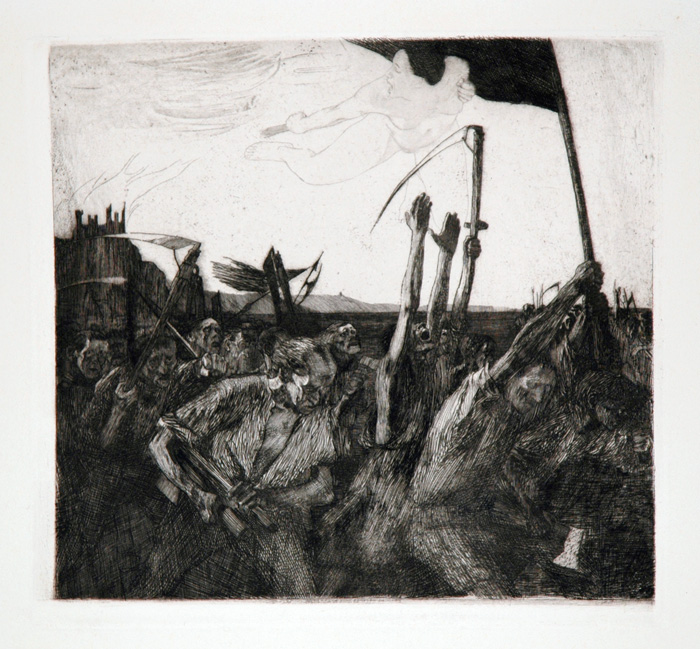 |
|
|
|
|
Aufruhr / Revolt (Kl. 44 viii, Knesebeck 46 IX). Original etching, drypoint, aquatint, brush etching, sandpaper and some roulette, 1899. Ours is a later impression printed by von der Becke c. 1946-48 after the removal of the engraved scripts listing Richter as the seller, Felsing as the printer, and Kollwitz as the artist; the lower right script ("Druck v. O. Felsing Berlin-Chlttbg") is still faintly visible printed underneath von der Becke's 3-line Berlin-Halensee dry stamp . This is one of Kollwitz's most famous prints, showing the spirit of revolution hovering in the air over an army of protesters. It is one of her most frequently illustrated works. A very rich and clear impression with sharp detail even in the shadows (note the flames coming out of the castle upper left). Image size: 295x315mm. Price: SOLD
|
|
|
|
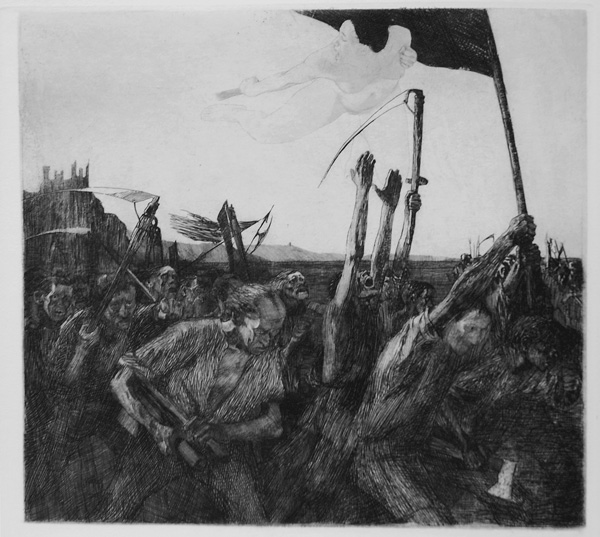 |
|
Aufruhr / Revolt (Kl. 44 viii, Knesebeck 46 IX). Original etching, drypoint, aquatint, brush etching, sandpaper and some roulette, 1899. Ours is a later impression printed by von der Becke c. 1946-48 after the removal of the engraved scripts listing Richter as the seller, Felsing as the printer, and Kollwitz as the artist; the lower right script ("Druck v. O. Felsing Berlin-Chlttbg") is still faintly visible printed underneath von der Becke's 3-line Berlin-Halensee dry stamp . This is one of Kollwitz's most famous prints, showing the spirit of revolution hovering in the air over an army of protesters. It is also one of her most frequently illustrated works. Ours is a rich and clear impression with sharp detail even in the shadows. The flames are almost gone, but a column of smoke can be seen rising at the top left margin. Image size: 295x315mm. Price: Please call or email for current pricing information.
|
|
|
|
|
 |
|
Aufruhr / Revolt (Kl. 44 viii, Knesebeck 44). Original etching, drypoint, aquatint, brush etching, sandpaper and some roulette, 1899. Ours is a later impression printed by von der Becke on lightly-yellow imitation Japon paper between 1946-48 and 1963-65 after the removal of the engraved scripts listing Richter as the seller, Felsing as the printer, and Kollwitz as the artist; the lower right script ("Druck v. O. Felsing Berlin-Chlttbg") is still faintly visible printed underneath von der Becke's 3-line Berlin-Halensee dry stamp . This is one of Kollwitz's most most famous prints, showing the spirit of revolution hovering in the air over an army of protesters. It is one of her most frequently illustrated works. There are later impressions in black on white paper and brownish-red ink (of which this is one) on cream colored papers. The plate no longer shows the fire and smoke from the burning castle, but the spirit of revolution and the onrushing crowd still print very well. Image size: 295x315mm. Price: Please call or email for current pricing information.
|
|
|
|
|
|
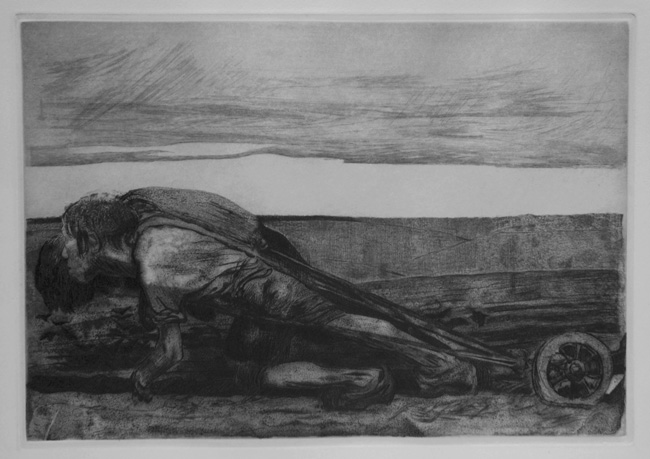 |
|
|
Die Pflüger / The Plowman (Kl. 94 ix b, Knesebeck 99 XIIb). Original etching and aquatint, before mid-January 1907. Edition: Our impression printed on copperplate paper (wove paper) by von der Becke with his 3-line Berlin-Halinsee blindstamp. Knesebeck describes that state as follows: "The script 'Originalradierung von Käthe Kollwitz' at lower right is erased. The engraved date '1921' remains. Editions by von der Becke between 1931 and 1941. a. Signed proofs on Japan, with Felsing’s signature. b. Mostly unsigned proofs, on copperplate paper and imitation Japan." The lines print well and there is detail in the dark areas. Sheet 1 of The Peasants' War. Signed in the plate. One of Kollwitz' most important woks, it is frequently illustrated in books, including those by Zigrosser, Hinz, Fecht, and the Kleins. The image depicts a peasant almost horizontal with the effort required to pull the plow, taking the place of a missing ox. Image size: 315x454mm. Price: Please call or email for current pricing information.
|
|
|
 |
|
|
|
Die Pflüger / The Plowman (Kl. 94 ix b, Knesebeck 99 XIIIb). Original etching and aquatint, before mid-January 1907. Edition: Our impression printed on copperplate paper (wove paper) by von der Becke with his 2-line Muenchen-22 blindstamp. Knesebeck describes that state (state XI) as follows: "The entire lower section of the composition - the ploughmen, the field and the far open country - are gone over with moulette or roulette. The work with needle bundle in the upper part of the sky prints incompletely. Proofs from the reworked plate as of 1946/48." State b is described as follows: "Editions between 1963/65 and 1972, in brown-violet, on thick, soft velin, with von der Becke’s Munich embossed seal." The color of the ink is dark enough that it looks almost black. The most conspicuous differences are in the sky, top left, where the lines in the sky are more defined and in the area around the wheel of the plow lower right, where the lines are thicker and less distinct. There is a lot more plate tone in the entire lower area thanks to the use of the roulette to add lots of pits that can hold and print ink. Sheet 1 of The Peasants' War. Signed in the plate. One of Kollwitz' most important woks, it is frequently illustrated in books, including those by Zigrosser, Hinz, Fecht, and the Kleins. The image depicts a peasant almost horizontal with the effort required to pull the plow, taking the place of a missing ox. Image size: 315x454mm. Price: Please call or email for current pricing information.
|
|
|
 |
|
|
|
Vergewaltigt / Raped (Kl. 97 v/viii, Knesebeck Va of VIII). Original etching, softground, sandpaper, drypoint, & aquatint, 1907. Edition: Ours is a proof before the 1908 edition and before the addition in 1921 of the date "1921" in the lower right corner: some of these were in brown, signed and in parts annotated, on Japan without Felsing’s signature; others were signed or unsigned, on copperplate paper, with Felsing’s signature; or, as ours, proofs signed differently than the edition, on copperplate paper, without Felsing’s signature. This is sheet 2 of The Peasants' War cycle. There are no posthumous reprints. At first glance it is easy to overlook the body, covered in blood, and lying in pools of it, which seems to have faded back into the earth from which it came and which could therefore be treated like dirt. In Kollwitz' visual narrative, it is this rape that provokes the peasants to rebel. Kollwitz said of this print in a 1908 letter to Georg Stolterforth, "It is just finished. It is an abducted woman, who after the devastation of her cottage is left lying in the herb garden, while her child, who had run away, looks over the fence." The child, visible at top left, her hair in a braid, is almost indistinguishable from the foliage growing against the fence. Condition: the paper has been slightly trimmed on all sides and shows traces of old glue at the corners; margins vary from 1-3/4 inches to 2-3/4 inches at the bottom. Image size: 412x529mm. Price: SOLD.
|
|
|
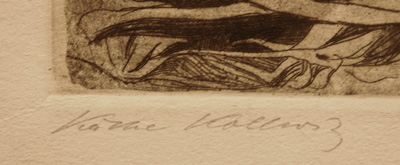 |
|
|
 |
|
|
Vergewaltigt / Raped (Kl. 97 vi a/viii, Knesebeck VIb of VIII). Original etching, softground, sandpaper, drypoint, & aquatint, 1907. Edition: Richter edition of 1921 with the date 1921 in the right corner before the engraved script at the bottom added for the 1924 Richter edition. Very good impression with plate-tone printed in brown ink on copperplate paper. There were 200 impressions signed in pencil. Sheet 2 of The Peasants' War. There are no posthumous reprints. It is easy to overlook the body, covered in blood, and lying in pools of it, which seems to have faded back into the earth from which it came and which could therefore be treated like dirt. In Kollwitz' visual narrative, it is this rape that provokes the peasants to rebel. Kollwitz said of this print in a 1908 letter to Georg Stolterforth, "It is just finished. It is an abducted woman, who after the devastation of her cottage is left lying in the herb garden, while her child, who had run away, looks over the fence." The child, visible at top left, her hair in a braid, is almost indistinguishable from the foliage growing against the fence. Condition: very good. Image size: 412x529mm. Price: NFS.
|
|
|
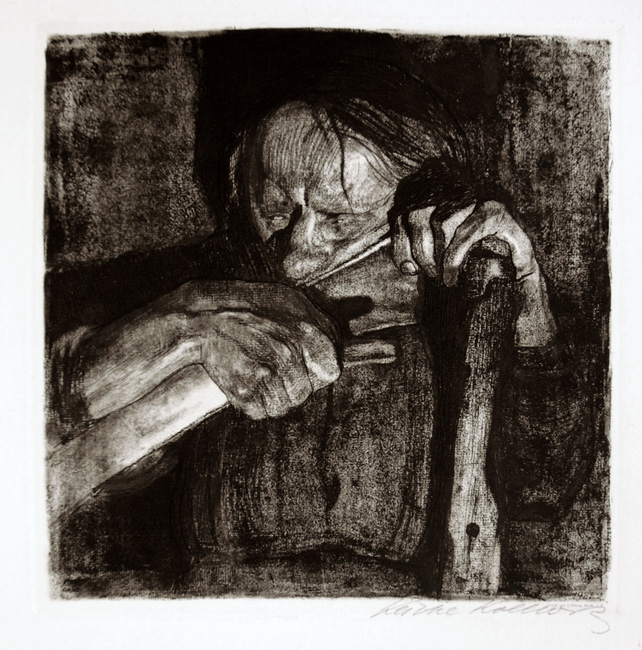 |
|
|
Bein Dengeln / Sharpening the scythe (Kl. 90 x / xii b, Knesebeck 88 XIb/XIVc). Original etching, drypopint, sandpaper, aquatint, and soft ground, 1905. Edition: Printed by Otto Felsing and published by Richter in 1921. Engraved lower right corner: "Druck von O. Felsing, Berlin S.W." with the added engraved annotation "1921" lower right. One of 200 impressions signed by Kollwitz. This is sheet 3 of The Peasants' War series. A brilliant impression of one of Kollwitz' most famous images on a very large sheet of "copperplate" (wove) paper measuring 732x568mm. The image is a very powerful one: a peasant sharpening his scythe and dreaming of revenge. Image size: 298x298mm. Price: Please call or email for current pricing information.
|
|
|
|
|
|
The presence of Felsing's address dates both this impression and the one below very precisely: for the 1924 Richter edition, Felsing’s address was removed. Replacing it at lower left is the engraved script: "VERLAG EMIL RICHTER, DRESDEN". At right: "Originalradierung von Käthe Kollwitz." In brown, on copperplate paper, some proofs on better paper. Unsigned, occasionally with accommodatory signatures. Some proofs with Richter’s stamp of the artist’s signature and with Richter’s embossed seal."
|
|
|
 |
|
Bein Dengeln / Sharpening the scythe (Kl. 90 x / xii b, Knesebeck 88 XIb/XIVc). Original etching, drypopint, sandpaper, aquatint, and soft ground, 1905. Edition: Printed by Otto Felsing and published by Richter in 1921. Engraved lower right corner: "Druck von O. Felsing, Berlin S.W." with the added engraved annotation "1921" lower right. Sheet 3 of The Peasants' War series. Remains of old tape on the reverse. A brilliant impression, probably printed after the 1921 edition and before the 1924 edition, of one of Kollwitz' most famous images: a peasant sharpening his scythe and dreaming of revenge. Image size: 298x298mm. Price: Please call or email for current pricing information.
|
|
|
|
|
|
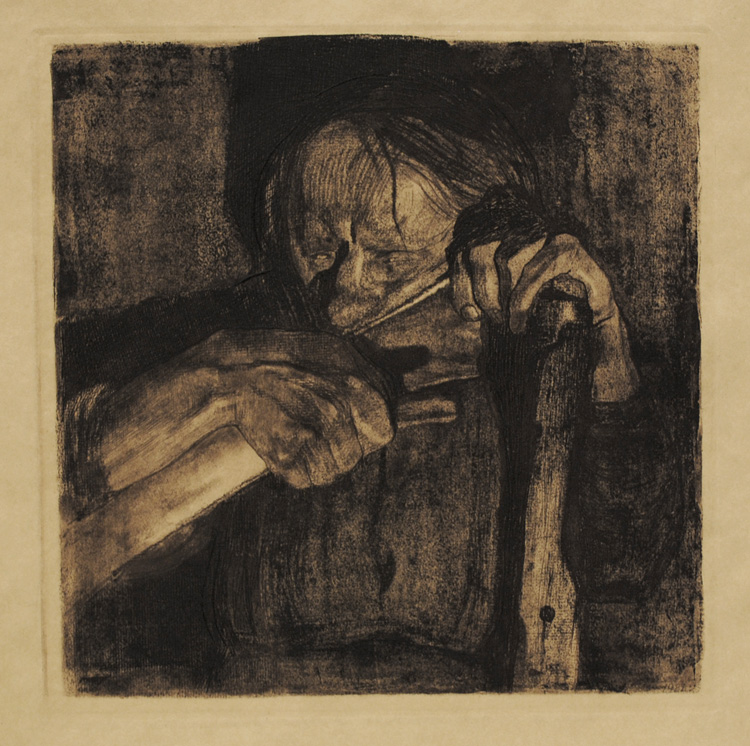 |
|
Bein Dengeln / Sharpening the scythe (Kl. 90, Knesebeck 88 XIVa/XIVc). Original etching, drypopint, sandpaper, aquatint, and soft ground, 1905. Edition: except for the date "1921", the remaining engraved script is removed. Editions by von der
Becke as of 1931: XIVa. Editions between 1931 and 1941. Mostly unsigned proofs, in brown, on copperplate paper or imitation Japan. Sheet 3 of The Peasants' War series. A rich impression of one of Kollwitz' most famous images: a peasant sharpening his scythe and dreaming of revenge. Image size: 298x298mm. Price: Please call or email for current pricing information.
|
|
|
|
 |
|
Bein Dengeln / Sharpening the scythe (Kl. 90, Knesebeck 88 XIVc/XIVc). Original etching, drypopint, sandpaper, aquatint, and soft ground, 1905. Edition: Published between 1963 and 1972 on soft thick vellum with von der Becke's Munich emboossed seal. Sheet 3 of The Peasants' War series. A very good impression of one of Kollwitz' most famous images: a peasant sharpening his scythe and dreaming of revenge. Image size: 298x298mm. Price: Please call or email for current pricing information.
|
|
|
|
|
|
 |
|
|
|
Inspiration (Kl. 91, Knesebeck 86 VIIc/X). Original etching, 1905. Edition: designed for The Peasants' War cycle, but not included. Before the engraved script of the 1921 Richter edition and before the row of nearly vertical lines at the middle section of the lower plate edge of the 1946/48 Von der Becke editions. Apparently a proof from the 1918 Richter edition. Printed by Felsing. This is another one of Kollwitz' most powerful etchings. Image size: 564x297mm. Price: Please call or email for current pricing information.
|
|
|
|
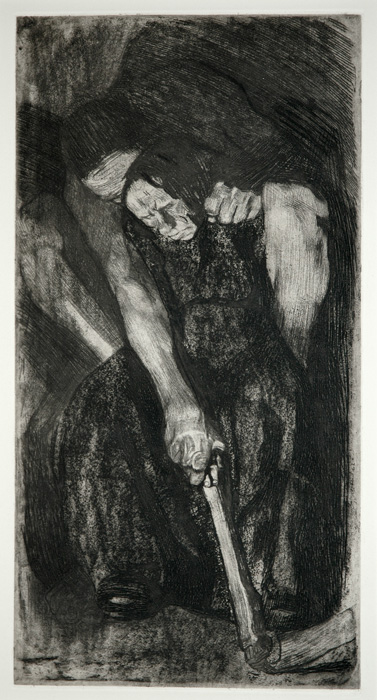 |
|
Inspiration (Kl. 91 ix/ix, Knesebeck 86 Xb). Original etching, 1904-05. Edition: designed for The Peasants' War cycle, but not included. Printed by Von der Becke (with his 2-line Muenchen-22 dry stamp). Knesebeckdescribes state X as follows: "With a row of nearly vertical lines at the middle section of the lower plate edge, it extends into the beveling. Editions by von der Becke as of 1946/48, in brown": "a. Editions between 1946/48 and 1963/65, on various papers, among which lightly yellow or yellow-brown imitation Japan, later on thick, soft velin, some with von der Becke’s stamp of the artist’s signature and/or with von der Becke’s three-line Berlin-Halensee embossed seal" and "b. Editions between 1963/65 and 1972, on thick, soft velin, with von der Becke’s Munich embossed seal." Image size: 564x297mm. Price: Please call or email for current pricing information.
|
|
|
|
|
|
 |
|
|
Bewaffnung in einem Gewölbe / Arming in a Vault (Kl. 95 VIII; von Knesebeck 96 IX). Original etching in two colors with line etching, drypoint, aquatint and soft ground with imprint of Ziegler’s transfer paper, before mid-June, 1906. Sheet 4 of the cycle Peasants’ War. State VII (c. 1908) has engraved on the plate edge at lower right: "Druck von O. Felsing, Berlin S.W." The 1921 Richter edition (state VIII) added the engraved date "1921" at the lower left edge of the composition and in the lower right corner of the composition. In State IX, the 1924 Richter edition, Felsing’s address is removed. Replacing it is the engraved script, at left: "Verlag Emil Richter, Dresden" and at right: "Originalradierung von Käthe Kollwitz." In State X, Richter’s address is removed. Since our impression has Richter's address and the text at right, it is clearly from the 1924 Richter edition. It is a very good impression and is signed in pencil lower right. Von Knesebeck cannot find any later editions aside from some proofs by von der Becke, c. 1931. The plate has been destroyed. This is one of Kollwitz' most powerful etchings (but so are so many others!). The force of the movement of the peasants from left to right suggests a branch shooting the rapids in a river, totally out of control, Image size: 497x327mm. Price: Please call or email for current pricing information.
|
|
|
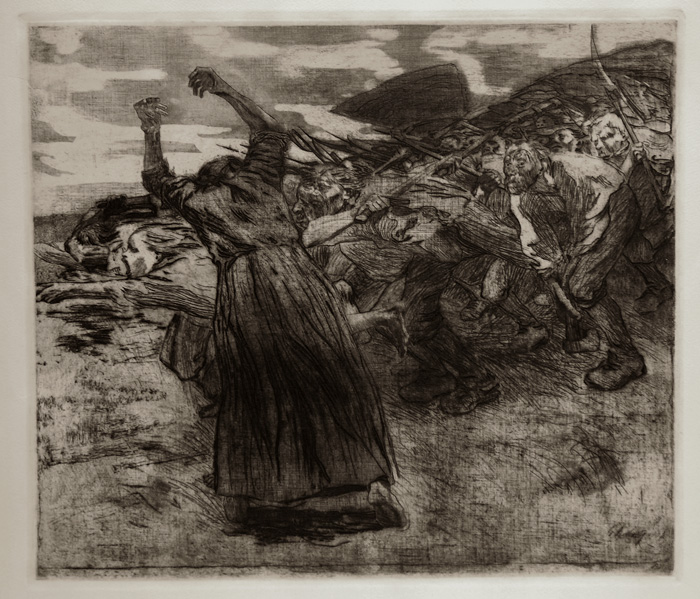 |
|
|
|
Losbruch / Charge (Kl. 66, Knesebeck 70 XIIIa). Original etching, drypoint, aquatint, and softground, 1902/03. Edition: printed between 1963/65 and 1972 in brown ink by von der Becke (with his 3-line Berlin-Halinsee seal). Signed "K. Kollwitz" in the plate lower right and dated 1902. Dated 1921 in the extreme lower right corner. Knesebeck describes state XIII as follows: "The area above and below the strip of flag at the upper left plate edge, and the lower left corner of the composition, are worked over either with moulette or roulette. Editions between 1946/48 and 1963/65, in brown, on various papers, among which lightly yellow or yellow-brown imitation Japan, later on thick, soft velin, some with von der Becke’s stamp of the artist’s signature and/or with von der Becke’s three-line Berlin-Halensee embossed seal." Ours is printed on thick, soft velin and has von der Becke's 3-line Berlin-Halinsee seal. Illustrated Zigrosser, pl. 19. In a letter of 1902, Kollwitz wrote about Losbruch, "I consider this Peasants' War print to be my best work and I am rather happy about it." Nagel felt that Revolt was "the most powerful print in the whole series" and added "This is indeed a Revolt; it explodes off the page as the peasants surge forth, there is an unmistakeable determination to fight in their haggard faces. The woman in the foreground raises her arms to give the signal. Kathe once told me that she had portrayed herself in this woman. She wanted the signal to attack to come from her" (p. 33). This etching has become one of the most immediately recognizable works of art of the 20th century! Sheet 5 of The Peasants' War. Image size: 513x587mm. Price: Please call or email for current pricing information.
|
|
|
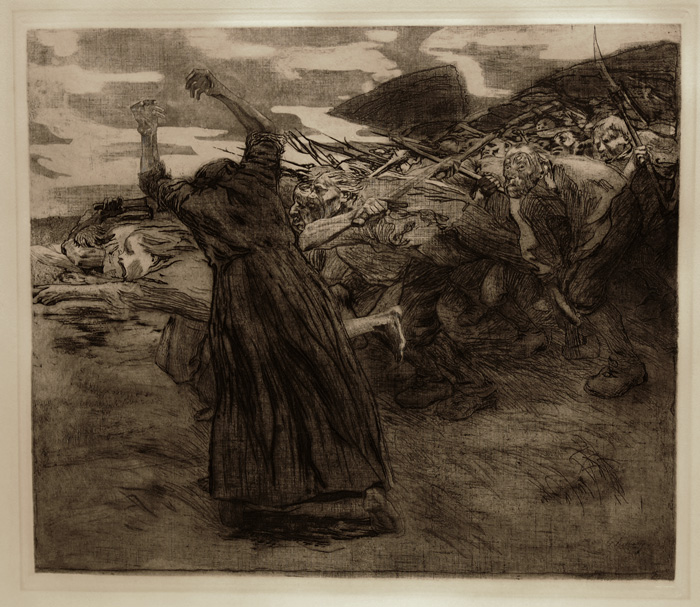 |
|
|
Losbruch / Charge (Kl. 66, Knesebeck 70 XIIIb). Original etching, drypoint, aquatint, and softground, 1902/03. Knesebeck notes of Sate XIIb: "The area above and below the strip of flag at the upper left plate edge, and the lower left corner of the composition, are worked over either with moulette or roulette. Editions between 1963/65 and 1972, in brown, on thick, soft velin, with von der Becke’s Munich embossed seal." Signed "K. Kollwitz" in the plate lower right and dated 1902. Dated 1921 in the extreme lower right corner. Illustrated Zigrosser, pl. 19. In a letter of 1902, Kollwitz wrote about Losbruch, "I consider this Peasants' War print to be my best work and I am rather happy about it." Nagel felt that Revolt was "the most powerful print in the whole series" and added "This is indeed a Revolt; it explodes off the page as the peasants surge forth, there is an unmistakeable determination to fight in their haggard faces. The woman in the foreground raises her arms to give the signal. Kathe once told me that she had portrayed herself in this woman. She wanted the signal to attack to come from her" (p. 33). This etching has become one of the most immediately recognizable works of art of the 20th century! Sheet 5 of The Peasants' War. Image size: 513x587mm. Price: Please call or email for current pricing information.
|
|
|
|
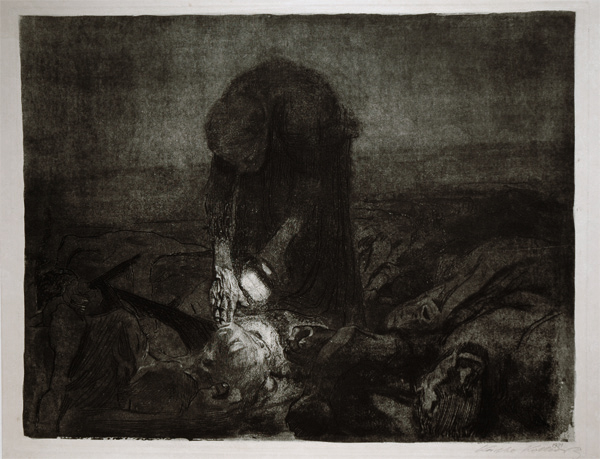 |
|
|
Schlachtfeld / After the battle (Klipstein 96 x/xii; Knesebeck 100 xii/xv). Original etching, drypoint, sandpaper, softground, & aquatint, with the imprint of ribbed laid paper, 1907. With the date 1921 in the right corner. Extremely good impression with plate-tone printed in green-black ink. Sheet 6 of The Peasants' War series. Signed in pencil. One of Kollwitz' most famous images: a woman, checking the fallen with a lantern, searching for her loved ones after the battle, touches the face of a dead boy with great tenderness and great grief. Ours is a rich and brilliant impression of the second edition of 200 impressions printed by Richter and signed by Kollwitz in the lower right corner under the image. There is a repaired puncture at the very bottom of the sheet at the extreme right far from the platemark. Image size: 412x529mm. Price: SOLD.
|
|
|
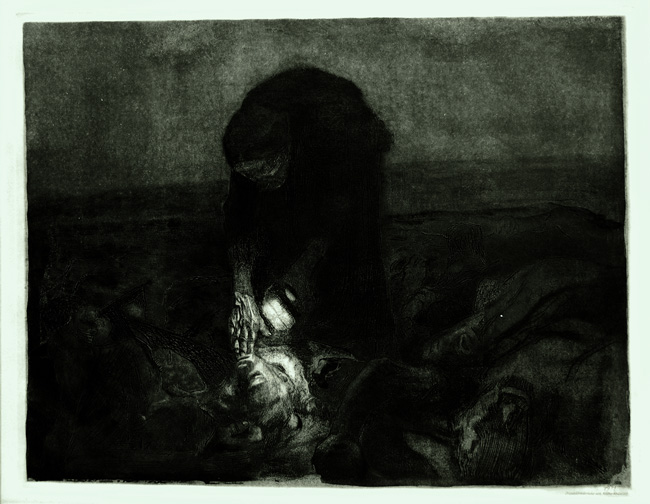 |
|
|
Schlachtfeld / After the battle (Klipstein 96 x/xii; Knesebeck 100 xiii/xv). Original etching, drypoint, sandpaper, softground, & aquatint, with the imprint of ribbed laid paper, 1907. With the date 1921 in the right corner. Extremely good impression with plate-tone printed in green-black ink. Sheet 6 of The Peasants' War series. Our impression dates from c. 1931 and is described by Knesebeck as state 13: "The engraved address of the publisher is removed, remaining are the date '1921' and 'Originalradierung von Käthe Kollwitz.' In green-black, on copperplate paper, with Felsing’s signature. Proofs by von der Becke, probably circa 1931." Ours seems to be one of the proofs by von der Becke printed around 1931 at Kollwitz' request. One of Kollwitz' most famous images: a woman, checking the fallen with a lantern, searching for her loved ones after the battle, touches the face of a dead boy with great tenderness and great grief. Ours is a very strong impression in greenish ink with good contrast and lots of sharp detail even in the darkest areas. Image size: 410x531mm. Price: SOLD.
|
|
|
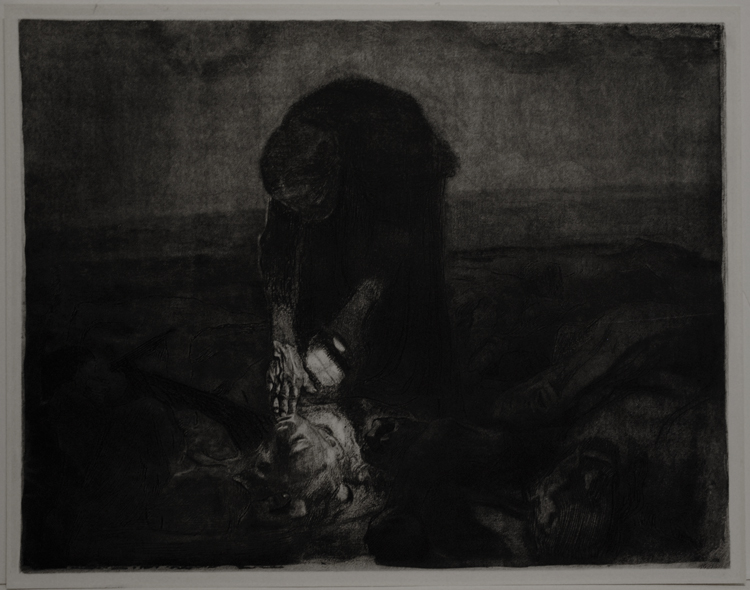 |
|
|
|
|
Schlachtfeld / After the battle (Klipstein 96 x/xii; Knesebeck 100 xv/xv b). Original etching, drypoint, sandpaper, softground, & aquatint, with the imprint of ribbed laid paper, 1907. With the date 1921 in the right corner. Very good impression printed in black ink. Sheet 6 of The Peasants' War series. Knesebeck describes this state as follows: State xv b: "Editions between 1963/65 and 1972, in green-black, on thick, soft velin, with von der Becke’s Munich embossed seal" ion the lower right corner of the plate. One of Kollwitz' most famous images: a woman, checking the fallen with a lantern, searching for her loved ones after the battle, touches the face of a dead boy with great tenderness and great grief. Ours is a very strong impression in very dark ink (more black than greenish black) with good contrast and lots of sharp detail even in the darkest areas. This sheet has beeen trimmed just outside the platemark (see photo above). Image size: 410x531mm. Price: Please call or email for current pricing information.
|
|
|
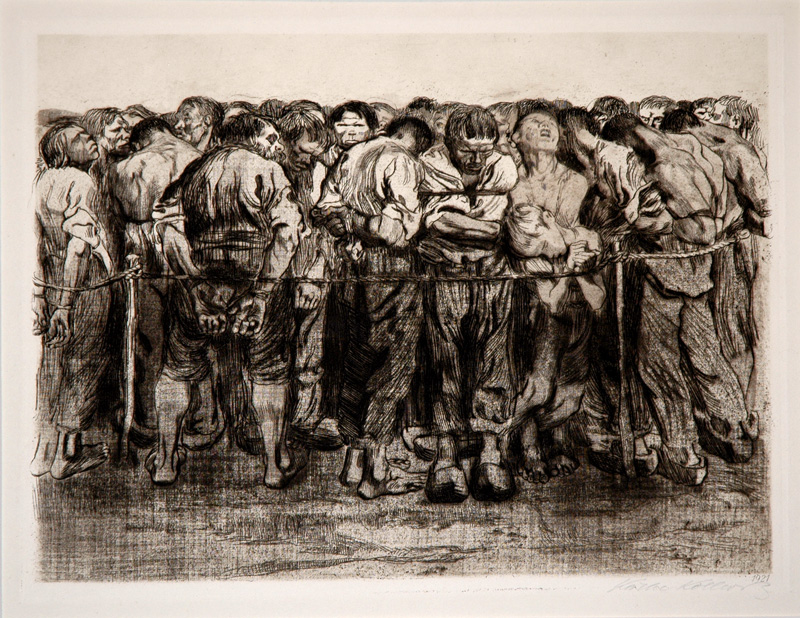 |
|
|
Die Gefangenen / The Prisoners (Kl. 98 Vb, Knesebeck 102 VI/X). Original etching, drypoint, sandpaper and soft ground with the imprint of fabric and Ziegler’s transfer
paper, 1908. This impression is from the edition printed in 1921 by Emil Richter, with the engraved date "1921" in the lower right corner of the composition; there were a total of 200 proofs in brown as part of this edition. Signed "Käthe Kollwitz" in the lower right corner. This is Plate 7 of Kollwitz' Peasants' War cycle. The defeated prisoners have been herded together for punishment and execution. One of her most frequently exhibited prints. Ours is a brilliant, sharp impression signed by Kollwitz lower right. Image size: 327x428mm. Price: SOLD.
|
|
|
 |
|
|
Die Gefangenen / The Prisoners (Kl. 98 VIIIb, Knesebeck 102 IXb /Xb). Original etching and softground, 1908. This is Plate 7 of Kollwitz' Peasants' War cycle. The defeated prisoners have been herded together for punishment and execution. Knesebeck describes state IXb as follows: "The remaining engraved script as well as the date '1921' are removed. Editions by von der Becke between 1931 and 1941, in brown. Mostly unsigned proofs on copperplate paper (wove paper) or imitation Japan." Ours is a very clear and sharp impression on copperplate paper pencil-signed lower right just beneath the platemark. The lines in the pants of the prisoners on the right in particular but all of the others generally are much sharper than they appear in the photograph. Nagel compares this print to the final plate of the Weaver's Revolt: "The weavers are defeated, resigned. It really is 'the end' for them. It is quite different for the captives of the Peasant's Revolt. They too are defeated, probably they will be executed, and yet this is not the end. Their faces are defiant, firmly they stand, feet planted apaprt. The artist has made much more powerful use of her etching technique. . . . All the figures in the later sequence are conceived on the grand scale. The figures are not cramped but set in space. There is neither scenery nor 'stage props' " (Nagel, p. 33). Image size: 327x423mm. Price: Please call or email for current pricing information.
|
|
|
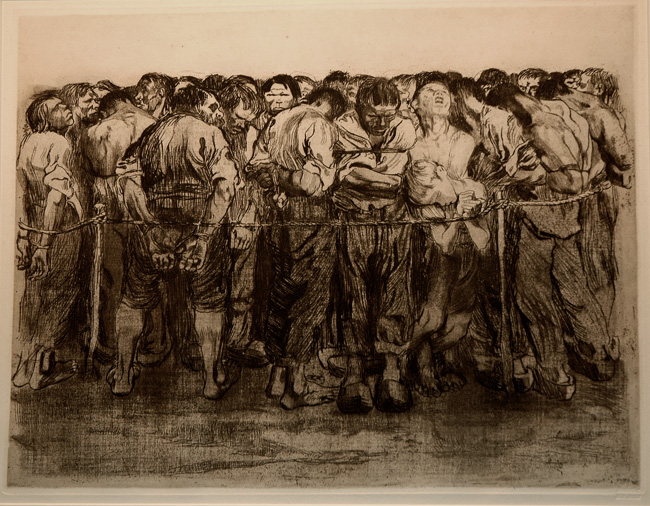 |
|
|
Die Gefangenen / The Prisoners (Kl. 98 VIIIb, Knesebeck 102 Xa /Xb). Original etching and softground, 1908. This is Plate 7 of Kollwitz' Peasants' War cycle. The defeated prisoners have been herded together for punishment and execution. Knesebeck describes state Xa as follows: "At the far left edge of the composition, two groups of diagonal lines are incised beneath the feet of the prisoner standing there, cross-hatching occurs upon his left foot. The sky prints somewhat blotchy. Proofs from the reworked plate published by von der Becke as of 1946/48. . . . Editions between 1946/48 and 1963/65, in brown-violet, with considerable tone, on various papers, among which lightly yellow or yellow-brown imitation Japan, later on thick, soft velin, some with von der Becke’s stamp of the artist’s signature and/or with von der Becke’s three-line Berlin-Halensee embossed seal." Ours is a very good impression on thick, soft velin with von der Becke’s three-line Berlin-Halensee embossed seal. The lines in the pants of the prisoners on the right in particular but all of the others generally are much sharper than they appear in the photograph. Nagel compares this print to the final plate of the Weaver's Revolt: "The weavers are defeated, resigned. It really is 'the end' for them. It is quite different for the captives of the Peasant's Revolt. They too are defeated, probably they will be executed, and yet this is not the end. Their faces are defiant, firmly they stand, feet planted apaprt. The artist has made much more powerful use of her etching technique. . . . All the figures in the later sequence are conceived on the grand scale. The figures are not cramped but set in space. There is neither scenery nor 'stage props' " (Nagel, p. 33). Image size: 327x423mm. Price: SOLD
|
|
|
 |
|
|
Die Gefangenen / The Prisoners (Kl. 98 VIIIb, Knesebeck 102 Xa /Xb). Original etching and softground, 1908. This is Plate 7 of Kollwitz' Peasants' War cycle. The defeated prisoners have been herded together for punishment and execution. Knesebeck describes state Xa as follows: "At the far left edge of the composition, two groups of diagonal lines are incised beneath the feet of the prisoner standing there, cross-hatching occurs upon his left foot. The sky prints somewhat blotchy. Proofs from the reworked plate published by von der Becke as of 1946/48. . . . Editions between 1946/48 and 1963/65, in brown-violet, with considerable tone, on various papers, among which lightly yellow or yellow-brown imitation Japan, later on thick, soft velin, some with von der Becke’s stamp of the artist’s signature and/or with von der Becke’s three-line Berlin-Halensee embossed seal." Ours is a very good impression on thick, soft velin with von der Becke’s three-line Berlin-Halensee embossed seal. The lines in the pants of the prisoners on the right in particular but all of the others generally are much sharper than they appear in the photograph. Nagel compares this print to the final plate of the Weaver's Revolt: "The weavers are defeated, resigned. It really is 'the end' for them. It is quite different for the captives of the Peasant's Revolt. They too are defeated, probably they will be executed, and yet this is not the end. Their faces are defiant, firmly they stand, feet planted apaprt. The artist has made much more powerful use of her etching technique. . . . All the figures in the later sequence are conceived on the grand scale. The figures are not cramped but set in space. There is neither scenery nor 'stage props' " (Nagel, p. 33). Image size: 327x423mm. Price: Please call or email for current pricing information.
|
|
|
 |
|
|
Die Gefangenen / The Prisoners (Kl. 98 VIIIb, Knesebeck 102 Xb /Xb). Original etching and softground, 1908. This is Plate 7 of Kollwitz' Peasants' War cycle. The defeated prisoners have been herded together for punishment and execution. Knesebeck describes state Xa as follows: "At the far left edge of the composition, two groups of diagonal lines are incised beneath the feet of the prisoner standing there, cross-hatching occurs upon his left foot. The sky prints somewhat blotchy. Proofs from the reworked plate published by von der Becke as of 1946/48. . . . Editions between 1963/65 and 1972, in brown-violet, on thick, soft velin, with von der Becke’s Munich embossed seal." Ours is a very good impression on thick, soft velin with von der Becke’s two-line Muenchen-22 embossed seal. The lines in the pants of the prisoners on the right in particular but all of the others generally are much sharper than they appear in the photograph. Nagel compares this print to the final plate of the Weaver's Revolt: "The weavers are defeated, resigned. It really is 'the end' for them. It is quite different for the captives of the Peasant's Revolt. They too are defeated, probably they will be executed, and yet this is not the end. Their faces are defiant, firmly they stand, feet planted apaprt. The artist has made much more powerful use of her etching technique. . . . All the figures in the later sequence are conceived on the grand scale. The figures are not cramped but set in space. There is neither scenery nor 'stage props' " (Nagel, p. 33). Image size: 327x423mm. Price: SOLD.
|
|
|
|
|
Spaightwood Galleries, Inc.
To purchase, call us at 1-800-809-3343 (1-508-529-2511 in Upton MA & vicinity) or send an email to spaightwood@gmail.com
We accept AmericanExpress, DiscoverCard, MasterCard, and Visa.
We also accept wire transfers and paypal.
For directions and visiting information, please call. We are, of course, always available over the web and by telephone (see above for contact information). Click the following for links to past shows and artists. For a visual tour of the gallery, please click here. For information about Andy Weiner and Sonja Hansard-Weiner, please click here. For a list of special offers currently available, see Specials.
All works are sold with an unconditional guarantee of authenticity (as described in our website listing).
Copyright 2004-2017, Spaightwood Galleries, Inc.
Go back to the top of this page.
Visiting hours: Saturday 10:00 am to 5:00 pm and Sunday noon to 6:00 pm and other times by arrangement.
Please call to confirm your visit. Browsers and guests are welcome.
|
|
|
|
|
|
|
|
|
|
|
|
|
|
|
|
|
|
|
|
|
|
|
|
|
|
|
|
|
|
|
|
|
|
|
|
|
|
|
|
|
|
|
|
|
|
|
|
|
|
|
|
|
|
|
|
|
|
|
|
|
|
|
|
|
|
























